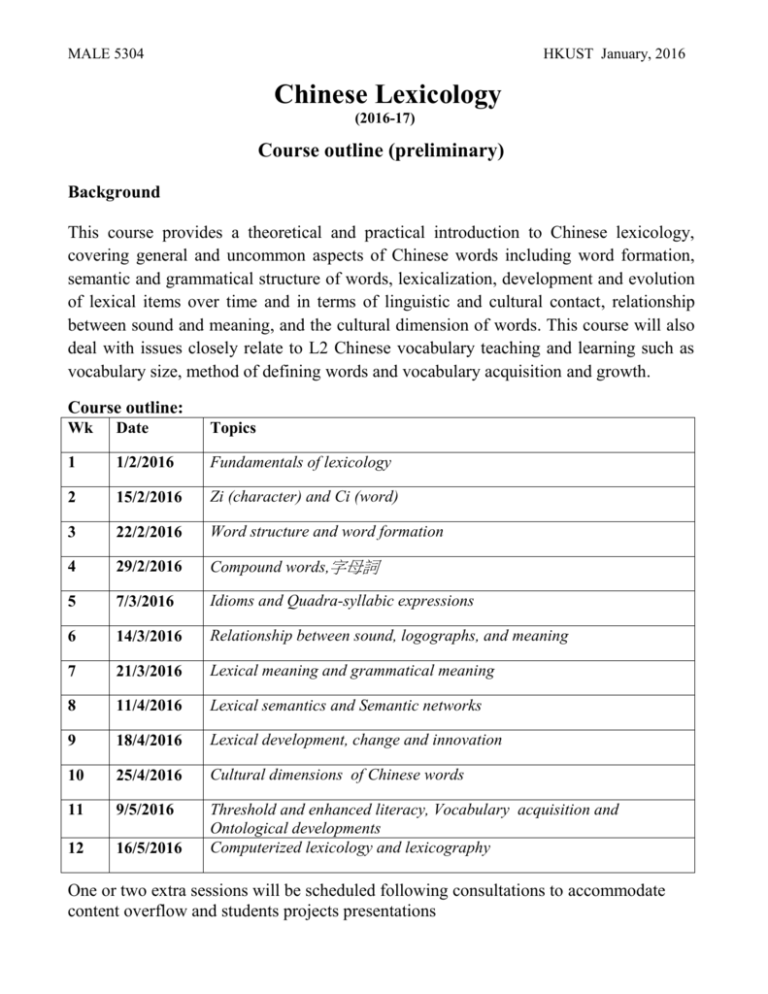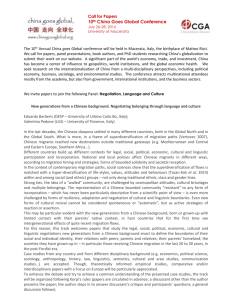Chinese Lexicology
advertisement

MALE 5304 HKUST January, 2016 Chinese Lexicology (2016-17) Course outline (preliminary) Background This course provides a theoretical and practical introduction to Chinese lexicology, covering general and uncommon aspects of Chinese words including word formation, semantic and grammatical structure of words, lexicalization, development and evolution of lexical items over time and in terms of linguistic and cultural contact, relationship between sound and meaning, and the cultural dimension of words. This course will also deal with issues closely relate to L2 Chinese vocabulary teaching and learning such as vocabulary size, method of defining words and vocabulary acquisition and growth. Course outline: Wk Date Topics 1 1/2/2016 Fundamentals of lexicology 2 15/2/2016 Zi (character) and Ci (word) 3 22/2/2016 Word structure and word formation 4 29/2/2016 Compound words,字母詞 5 7/3/2016 Idioms and Quadra-syllabic expressions 6 14/3/2016 Relationship between sound, logographs, and meaning 7 21/3/2016 Lexical meaning and grammatical meaning 8 11/4/2016 Lexical semantics and Semantic networks 9 18/4/2016 Lexical development, change and innovation 10 25/4/2016 Cultural dimensions of Chinese words 11 9/5/2016 12 16/5/2016 Threshold and enhanced literacy, Vocabulary acquisition and Ontological developments Computerized lexicology and lexicography One or two extra sessions will be scheduled following consultations to accommodate content overflow and students projects presentations MALE 5304 HKUST January, 2016 Delivery mode: a combination of lectures and seminars Learning outcomes: On completing this course, students will: 1. be able to analyze and appreciate basic concepts in Chinese lexicology including zi (字 ) and word (詞 ) in different contexts; compound and complex words; idiomatic expressions; lexical meaning and grammatical meaning; synonymy; antonymy; hypernymy; hyponymy; word structure and word formation; 2. have an overall understanding of Chinese word development over time and across different speech communities; 3. gain familiarity with new approaches and methodologies in lexicology including aspects of lexical semantics; 4. gain knowledge of computational basis for lexicology and lexicography, and of learner dictionary 5. develop enhanced abilities to deal with pedagogical issues in Chinese vocabulary teaching. Assessment scheme (including rationale): Task nature Description Class participation Assignment 1 or 2: Weight 10 % 15 % Class Quiz : Assesses the students' learning of course 25 % content covered in lectures and reading materials throughout the entire course. Project: Allows students to work on a relevant topic in the course. (i) Presentation: 15 % (ii) Final report: 35 % MALE 5304 HKUST January, 2016 Recommended learning resources: Basic references Packard, Jerome: The Morphology of Chinese: A Linguistic and Cognitive Approach. Cambridge, UK: Cambridge University Press. 2000. 劉叔新:《漢語描寫詞彚學》,北京:商務印書館。1990。 Some additional recommended material Chao, Yuen Ren. (1948). Mandarin primer, an intensive course in spoken Chinese. Cambridge, Harvard University Press. Chao, Yuen Ren. (1968). A grammar of spoken Chinese. University of California Press. Chen, P. (1999). Modern Chinese: History and sociolinguistics. Cambridge: Cambridge University Press. Coleman, Julie and Christian J. Kay (Eds.). Lexicology, Semantics and Lexicography, Amsterdam/Philadelphia: John Benjamins. 2000. Geeraerts, Dirk. Theories of Lexical Semantics, Oxford university Press. 2010. Kwong, O.Y., and Tsou, Benjamin. (2004). “The Usage and Perception of Judgment Terms in the Pan-Chinese Context” () Recent Advancement in Chinese Lexical Semantics, Proceeding of 5th Chinese Lexical Semantics Workshop (CLSW-5) (ed Ji Dong Hong, Lua Kim Teng and Wang Hui) pp.220-227. Lees, Robert B. (1960). The Grammar of English Nominalizations: International Journal of American Linguistics V26, No. 3, Part 2. LIVAC 《中文各地區共時詞語研究報告》Language Information Sciences Research Centre, City University of Hong Kong, 2002 (http://www.livac.org/) Lyons, John: Linguistic Semantics: An Introduction. Cambridge, UK: Cambridge University Press. 1995. Packard, Jerome (ed.). New Approaches to Chinese Word Formation, Berlin: Mouton de Gruyter. 1998. Saeed, John: Semantics. Cambridge MA and Oxford UK: Blackwell Publishers. 1997. Tsou, K Benjamin. (1975) “On the Linguistic Covariants of Cultural Assimilation”, Anthropological Linguistics, Vol. 17, No. 9, pp.445-465. Tsou, Benjamin (1976) "Sound symbolism and some socio- and historical linguistic implications of linguistic diversity in Sino-Tibetan languages", in Cahiers de Linguistique d'Asie Orientale no. 3, pp. 67-76. MALE 5304 HKUST January, 2016 Tsou, Benjamin. (2000) “A Window on Re-lexification in Chinese”. In In Memory of Professor Li Fang-kuei: Essays on Linguistic Change and the Chinese Dialects 語言 變化與漢語方言:李方桂先生紀念論文集. Eds. Anne Yue & Ting Pang-hsin, pp.5372. Seattle/Taipei: University of Washington & Academia Sinica. Tsou, Benjamin K.( 2001). “Language Contact and Lexical Innovation” in New Terms for New Ideas: Western Knowledge & Lexical Change in Late Imperial Chinese (ed. M. Lackner, I. Amelung & J. Kurtz) J Brill: Berlin, pp.35-56, 2001. Tsou, Benjamin, and Kwong, Olivia. (in press). "Some Quantitative and Qualitative Characteristic Features of the Chinese Language". In Wang S.-Y. William and Sun C.F. (eds) Oxford Handbook of Chinese Language and Linguistics. Oxford University Press. Tsou, Benjamin, and Kwong, Olivia. (2015). "LIVAC as a Monitoring Corpus for Tracking Trends Beyond Linguistics". Journal of Chinese Linguistics, Monograph 25. Hong Kong: Chinese University of Hong Kong Press, pp.447-471. Yuen, R., W F Tsoi and B K Tsou. (2004).漢語詞語與詞素之正負面: 三地褒貶詞語初探 in Recent Advancement in Chinese Lexical Semantics, Proceeding of 5th Chinese Lexical Semantics Workshop (CLSW-5) (ed Ji Dong Hong, Lua Kim Teng and Wang Hui) pp228-236. 符淮清 (2004):《現代漢語詞彙》(增訂本),北京:北京大學出版社。 陸志偉 (1957) :《漢語的構詞法》,科學出版社 。 橋本萬太郎 (1985) :《語言地理類型學》, 余志鴻譯,北京:北京大學出版社 。 董秀芳 (2011) :《詞彙化:漢語雙音詞的衍生和發展》(修訂本),北京:商務印 書館。 鄒嘉彥和馮良珍 (2000):“漢語(五地)與日語新概念詞語對比研究—從新聞視窗看 詞匯衍生與重整” 《語言研究》, 3:51-70。 鄒嘉彥 、錢志安和 蔡永富 (2003) :“從漢語共時語料庫中 “ 吧 ” 類詞探討新詞衍生規 律的問題”,《中國社會語言學學術研討會》, 澳門, 21-23 Nov 2003。 鄒嘉彥和游汝杰(編)(2004): 《語言接觸論文集》, 上海,上海教育出版社。 鄒嘉彥和游汝杰(編)(2010): 《全球華語新詞語詞典》,北京,商務印書館。 Tutor: Professor Benjamin Tsou Email: btsou99@gmail.com Link: http://goo.gl/lk5MO0






